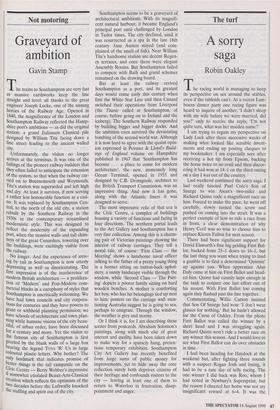Not motoring
Graveyard of ambition
Gavin Stamp
The trains to Southampton are very fast as massive earthworks keep the line straight and level: all thanks to the great engineer Joseph Locke, one of the unsung heroes of the Railway Age. Opened in 1840, the magnificence of the London and Southampton Railway reflected the Hamp- shire port's ambitions — as did the original station: a grand Italianate Classical pile designed by William Tite facing down a fine street leading to the ancient walled city.
Unfortunately, the visitor no longer arrives at the terminus. It was one of the failings of the pioneer railway builders that they often failed to anticipate the extension of the system, so that when the railway ear- ned on to Bournemouth and Weymouth, Tite's station was superseded and left high and dry. At least it survives, if now serving a rather less honourable function as a casi- no. It was replaced by Southampton Cen- tral, to the north of the old city, a station rebuilt by the Southern Railway in the 1930s in the contemporary streamlined modernistic style. This was designed to reflect the modernity of the expanding Port, when the massive walls and tall chim- neys of the great Cunarders, towering over the buildings, were excitingly visible from the railway. No longer. And the experience of arriv- ing by rail in Southampton is now utterly depressing as well as disorientating. The first impression is of the incoherence of modern British architecture — a prolifera- tion of 'Modern' and Post-Modern com- mercial blocks in a cacophony of styles that Southampton is uncritically welcoming. We have had town councils and city corpora- tions for centuries and they have powers to grant or withhold planning permission; we have schools of architecture and town plan- ning while humane visions of the city beau- tiful, of urban order, have been discussed for a century and more. Yet the visitor to the famous city of Southampton is first greeted by the blank walls of a large box bearing the legend TOYS 'R' Us in large coloured plastic letters. Why bother? The Only landmark that indicates promise of better things is the tall campanile on the Civic Centre — Berry Webber's impressive if somewhat etiolated Beaux-Arts-Classical creation which reflects the optimism of the two decades before the Luftwaffe knocked the stuffing and spirit out of the city. Southampton seems to be a graveyard of architectural ambitions. With its magnifi- cent natural harbour, it became England's principal port until challenged by London in Tudor times. The city declined, until it was resurrected as a spa in the late 18th century. Jane Austen stayed (and com- plained of the smell of fish). Near William Tite's handsome station are decent Regen- cy terraces, and once there were elegant Assembly Rooms. But Southampton failed to compete with Bath and grand schemes remained on the drawing board.
But at least the railway revived Southampton as a port, and its greatest days would come early this century when first the White Star Line and then Cunard switched their operations from Liverpool (the Titanic called at Southampton, of course, before going on to Ireland and the iceberg). The Southern Railway responded by building bigger and bigger docks. And the ambition even survived the devastating bombing of the second world war. Although it is now hard to agree with the quaint opin- ion expressed in Pevsner & Lloyd's Build- ings of England volume on Hampshire published in 1967 that 'Southampton has become . . a place to come for modern architecture', the new, immensely long Ocean Terminal, opened in 1953 and designed by C.B. Dromgoole, architect to the British Transport Commission, was an impressive thing. And now it has gone, along with the Atlantic liners it was designed to serve.
The most impressive relic of that era is the Civic Centre, a complex of buildings housing a variety of functions and facing in four directions. The northern portal leads to the Art Gallery and Southampton has a very fine collection. Among this is a charm- ing pair of Victorian paintings showing the interior of railway carriages. They tell a moral tale, of course: 'First Class — the Meeting' shows a handsome naval officer talking to the father of a pretty young thing in a bonnet sitting on button-back uphol- stery, a sunny landscape visible through the window, while 'Second Class — The Part- ing' depicts a poorer family sitting on hard wooden benches. A mother is comforting her boy, who has his belongings tied up next to him; posters on the carriage wall men- tioning Australia suggest he is going to sea, perhaps to emigrate. Through the window, the weather is grey and stormy.
Or I think it is, for I am describing these scenes from postcards. Abraham Solomon's paintings, along with much else of great interest and quality, have been taken down to make way for a sparsely hung, preten- tious temporary exhibition. Southampton City Art Gallery has recently benefited from large sums of public money for improvements, yet to hide away the core collection surely both deprives citizens of their heritage and confounds visitors to the city — leaving at least one of them to return to Waterloo in frustration, disap- pointment and anger.


























































 Previous page
Previous page